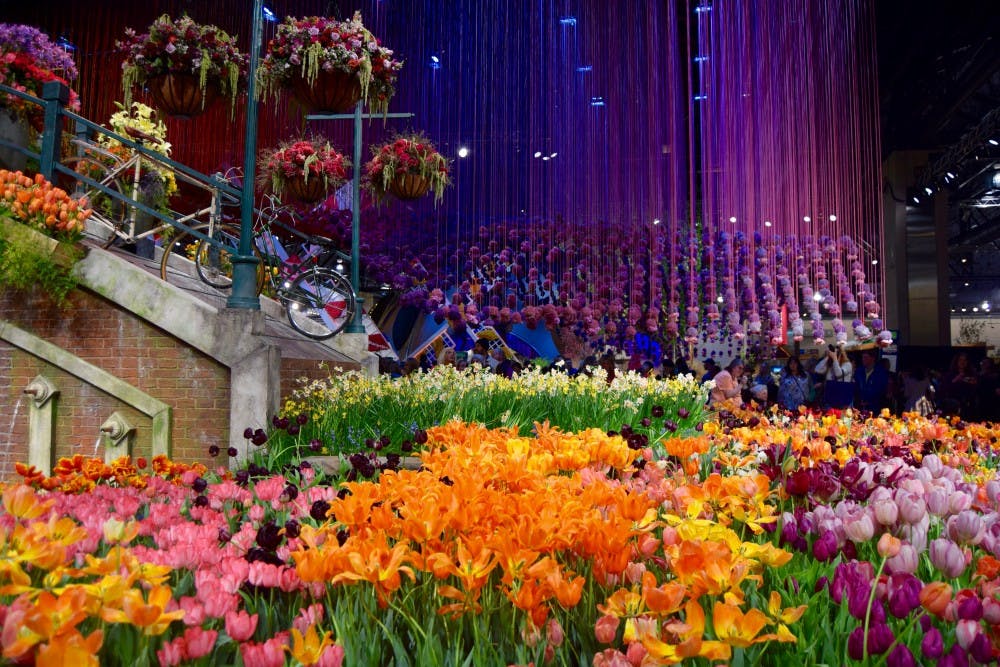There's a floral oasis blooming near Reading Terminal Market.
Each year, the Philadelphia Convention Center transforms into a gardener’s slice of heaven: 10 acres of floral exhibition space. The Flower Show has been around since 1829 and is the oldest and largest flower show in the United States. It was founded by a group of gentleman farmers, botanists and gardeners who got together to share knowledge with each other and other parts of the world. They used to gather to show off their favorite plants and prized fruits and vegetables. Today, you can walk into the Horticourt, where amateurs can be a part of the flower show. Even if your idea of gardening is growing a plant on your windowsill, you can compete in the show and possibly walk away with a blue ribbon. And if you're not the best gardener, you can check out the Design Studio to create your own flower crown or flower arrangement before or after the show.

This year's show, which brought in over 250,000 visitors, was themed “Holland: Flowering the World.” Guests didn’t have to stop to smell the tulips this year; the sweet aroma of flowers filled the venue.
When guests walked through the entrance of the exhibition hall, they found themselves immersed in an infinite field of flowers—a staple of Holland. A never–before–done floral canopy hung over the entrance garden. Four thousand multi–colored strings were hung from the rafters of the convention center, each with a ball of dried–cut flowers at the bottom. This emulated the view of the field of flowers stretching infinitely into the horizon.
Pennsylvania Horticultural Society spokesperson Alan Jaffe said the goal of the entrance was to make visitors “feel like [they were] surrounded by this floral beauty above and below.”

Jaffe believes they captured the theme precisely this year. The Horticultural Society had three designers from the Netherlands come to design exhibits. Inspiration for the other exhibits stemmed from different ways of traditional Dutch landscaping and gardening, as well as interpretations of Dutch history and art. The Dutch approach gardening and landscaping in innovative ways, and designers adapted those techniques to their exhibits. Jaffe confirmed that show visitors from the Netherlands, particularly individuals representing Dutch media, said that the “show expresses the nature and feelings of the Dutch very well.”
The Flower Show also emphasized environmental sustainability, from talks from the Pennsylvania Horticultural Society to bicycles hanging within the venue. Holland's latest green technologies were also displayed at the show; a highlight was the Dutch Ecodome, a massive tent–like space for agriculture. The dome had to be broken into 100 pieces and shipped to the Flower Show for its first American appearance.
The 70–foot–wide, 30–foot–tall exhibit was covered by a moss that filters vehicle exhaust. Other features of it included a dust reduction system, solar energy, methods of converting rain water into drinking water, climbing plants, bio–based furniture, an insect hotel and more. Jaffe says the Ecodome is “about living in a better way on planet earth”—something we all can take part in, horticulturists or not.

Guests also had opportunities to learn about ways to repurpose, recycle and use organic practices. Jaffe claims, “No matter what level of gardener you are, you can come [to the show] and learn how to improve your horticultural skills.” On the Gardener’s Studio stage in the middle of the floor, talks took place, and their topics included container gardening, attracting pollinators, growing orchids and more.
On your way out of the show, you can shop until you literally wilt, like the tulips on Sunday (Ed. note: Don’t wait until the last day to go.) Over 180 vendors lined up to sell everything garden–related, ranging from gardening tools to botanical art to jewelry. You can also purchase Gold Medal plants at the PHS’s own big shop.
If the price of the show ($22.00 for students) is preventing you from wanting to attend, the use of the proceeds might convince you to dig a little deeper into your wallet. “Everybody who comes to the show has an impact on the greater Philadelphia region," Jaffe said. The proceeds of the Pennsylvania Horticultural Society’s biggest fundraiser of the year go toward donations of fresh, healthy food and produce to our neighbors in low–income areas, the creation of community gardens, the planting of trees that have been lost due to city and regional development, land care efforts, neighborhood transformation and the beautification of the city.
So if you’re looking for a beautiful and educational way to spring into spring next year, carve out a few hours, wear comfortable shoes, pack your camera and check out the Flower Show. The International Festivals and Events Association has named the show the best event in the world—beating out strong competitors like the Kentucky Derby. There's a reason the event was included in the book 1,000 Ways to Die — and now, you can see it before you graduate.







